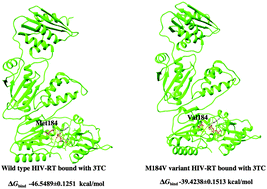An integrated molecular dynamics, principal component analysis and residue interaction network approach reveals the impact of M184V mutation on HIV reverse transcriptase resistance to lamivudine†
Abstract
The emergence of different drug resistant strains of HIV-1 reverse transcriptase (HIV RT) remains of prime interest in relation to viral pathogenesis as well as drug development. Amongst those mutations, M184V was found to cause a complete loss of ligand fitness. In this study, we report the first account of the molecular impact of M184V mutation on HIV RT resistance to 3TC (lamivudine) using an integrated computational approach. This involved molecular dynamics simulation, binding free energy analysis, principle component analysis (PCA) and residue interaction networks (RINs). Results clearly confirmed that M184V mutation leads to steric conflict between 3TC and the beta branched side chain of valine, decreases the ligand (3TC) binding affinity by ∼7 kcal mol−1 when compared to the wild type, changes the overall conformational landscape of the protein and distorts the native enzyme residue–residue interaction network. The comprehensive molecular insight gained from this study should be of great importance in understanding drug resistance against HIV RT as well as assisting in the design of novel reverse transcriptase inhibitors with high ligand efficacy on resistant strains.


 Please wait while we load your content...
Please wait while we load your content...